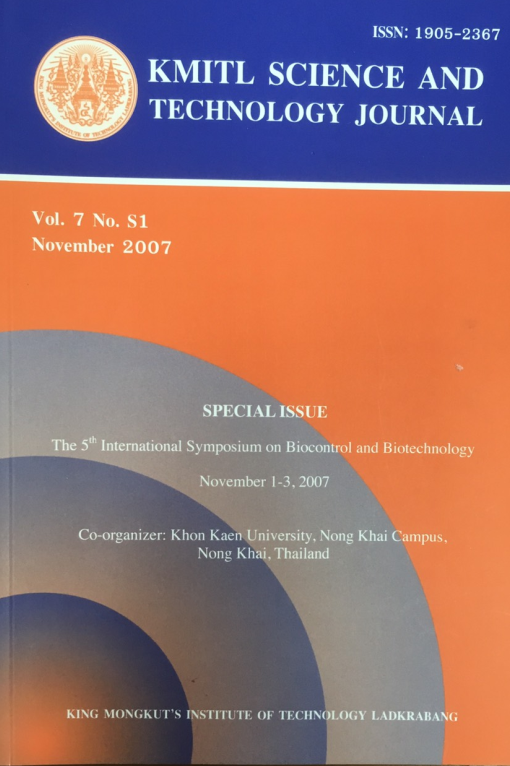ASPARAGINASE PRODUCTION BY ENDOPHYTIC FUNGI ISOLATED FROM SOME THAI MEDICINAL PLANTS
Main Article Content
Abstract
Asparaginase is an important enzyme used as an anti-cancer compound. Five Thai medicinal plants, Hiptage benghalensis, Betula alnoides, Adenanthera microsperma, Eupatorium odoratum and Houttuynia cordata were used for fungal isolation by triple surface sterilization method. One hundred and seventeen isolates of endophytic fungi were evaluated for asparaginase production using qualitative and quantitative analyses. Twenty-five isolates demonstrated pink zone around their colonies in the agar plate assays. Fungal isolates from H. benghalensis and E. odoratum were highly active when tested with the spectrophotometric method. The endophytic fungi with high activity are proposed as a possible asparaginase source to manage cancer cells.
Keywords: endophytic fungi, Thai medicinal plants, asparaginase
Corresponding author: E-mail: scboi009@chiangmai.ac.th
Article Details
Copyright Transfer Statement
The copyright of this article is transferred to Current Applied Science and Technology journal with effect if and when the article is accepted for publication. The copyright transfer covers the exclusive right to reproduce and distribute the article, including reprints, translations, photographic reproductions, electronic form (offline, online) or any other reproductions of similar nature.
The author warrants that this contribution is original and that he/she has full power to make this grant. The author signs for and accepts responsibility for releasing this material on behalf of any and all co-authors.
Here is the link for download: Copyright transfer form.pdf
References
[2] Gulati, R., Saxena, R. K. and Gupta, R.A. 1997 Rapid Plate Assay for Screening L- Asparaginase Producing Micro-organisms, Letters in Applied Microbiology, 24, 23-26.
[3] Serquis, M.I.de.M., Oliveira, E.M.M., Santos, A.S. and Costa, G.L.da. 2004 Production of L- Asparaginase by Filamentous Fungi, Memérias do Instituto Osvaldo Cruz, 99(5), 489-492.
[4] Dunlop, P.C., Meyer, G.M. and Roon, R.J. 1980 Nitrogen Catabolite Repression of Asparaginase II in Saccharomyces cerevisiae, Journal of Bacteriology, 143, 422-426.
[5] Ferrara, M.A., Severino, N.M.B., Mansure, J.J., Martin, A.S., Oliveira, E.M.M., Siani, A.C., Jr, N.P., Torres, F.A.G. and Bon, E.P.S. 2006 Asparaginase Production by a Recombinant Pichia pastoris Strain Harbouring Saccharomyces cerevisiae ASP3 Gene, Enzyme and Microbial Technology, 39, 1457-1463.
[6] Geckil, H. and Gencer, S. 2004 Production of L- asparaginase in Enterobacter aerogenes Expressing Vitreoscilla Hemoglobin for Efficient Oxygen Uptake, Applied Microbiology and Biotechnology, 63, 691-697.
[7] Maladkar, N.K., Singh, V.K. and Naik, S.R. 1993 Fermentative Production and Isolation of L- Asparaginase from Erwinia carotovora, Hindustan Antibiotics Bulletin, 35, 77-86.
[8] McCredie, K.B., Ho, D.H.W. and Freireich, E.J. 1973 L- Asparaginase for Treatment of Cancer, A Cancer Journal for Clinicians, 23, 220-227.
[9] Taylor, J.E., Hyde, K.D. and Jones, E.B.G. 1999 Endophytic Fungi Associated with The Temperate Palm Trachycarpus fortune Within and Outside Its Natural Geographic Range, New Phytologist, 142, 335-346.
[10] Bussabarn, B., Lumyong, S., Lumyong, P., McKenzie, E.C. and Hyde, K.D. 2001 Endophytic fungi from Amomum siamense, Canadian Journal of Microbiology, 47, 943-948.
[11] Imada, A., Igarasi, S., Nakahama, K. and Isono, M. 1973 Asparaginase and Glutaminase Activities of Micro-organisms, Journal of General Microbiology, 76, 85-99.
[12] Hölker, U., Höfer, M. and Lenz, J. 2004 Biotechnological Advantages of Laboratory-scale Solid-state Fermentation with Fungi, Applied Microbiology and Biotechnology, 64, 175-186.
[13] Lee, S.Y., Nakajima, I., Ihara, F., Kinoshita, H. and Nihira, T. 2005 Cultivation of Entomopathogenic Fungi for the Search of Antibacterial Compounds, Mycopathologia, 160, 321-325.


